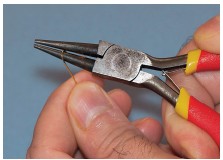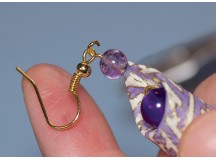
Wirework
Hoops, rings, hooks, eyelets, and wraps formed of jeweler’s wire are the mainstay of jewelry making.
This is collectively called “wirework,” because professional jewelers often make their own findings from spools of wire. Wirework comes with its own jargon and terminology. For our purposes we shall employ only a few terms to get you started:
• Eye pins—one end is a split ring, forming a closed loop, the other is a pin
• Head pins—one end is wider, shaped like a nailhead, large enough to retain a bead
• Jump rings—simple split rings and special shapes used as links to connect elements
• Ear wires—hook-shaped loops for inserting into pierced earlobes
Although jewelers make their own findings and wire fittings, pre-formed pins, rings, and loops are now widely available, made perfectly by machine, and found in online jewelry supply houses, crafts superstores, and most larger department stores.
“Precious metals” refers to gold, silver, and platinum. Metal wires containing appreciable amounts of precious metals are much more expensive, and with the exception of gold, can require fussy care. The most common jewelry wires and wire findings are formed of base metals: copper, nickel, iron/steel, and brass. Research and become familiar with the peculiar world of metal jewelry terminology; for example, so-called nickel-silver wire looks like silver, but surprisingly, does not contain any silver. These base metals can also be electroplated to look like other metals. These “plated” finishes can be so thin that they may rub off with wear or with cleaning in harsh chemicals. Both plated silver and sterling silver easily tarnish unless coated to prevent this. So-called “filled” wire has a thicker precious metal layer over the base metal (thicker than a “plated” product). Take care when you are working with coated and filled wires as cutters and unprotected plier jaws can sometimes easily mar them. If you are rough, it can even flake off.
Aluminum fittings are also available, but thin aluminum fittings are not strong. Steel findings of similar size are much stronger, but they will rust unless you select special grades of surgical or stainless steel. The latter two are more durable, and favored by people allergic to other metals, but since they are stronger they can be more difficult to work.
Wire comes in a wide variety of gauges (diameters) and cross-sectional shapes (round, square, triangular, or half-round— to name a few). Silver wire comes in a variety of tempers or degrees of stiffness, which can range from “dead soft” to “hard.” As the wire is physically worked, even by just tapping or bending, the temper also changes (making it more stiff and brittle). Similarly, heating and then cooling it carefully softens the atomic structure of the metal in a process called annealing. Expert wire-workers use these characteristics to their advantage.

